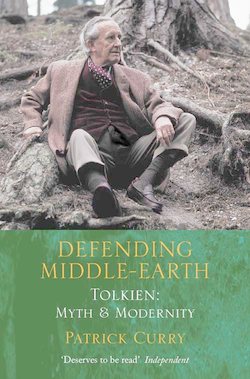Читать книгу Defending Middle-earth: Tolkien: Myth and Modernity - Patrick Curry - Страница 11
A Mythology for England?
ОглавлениеFor Tolkien himself, of course, and for English readers, the native cultural idiom happens to be an English one. Part of Tolkien’s ambition was ‘to restore to the English an epic tradition and present them with a mythology of their own’ – something that he felt was lacking in their national literature. (The Arthurian myth-cycle was, he felt, powerful but ‘imperfectly naturalized’: more British, that is, Celtic, than English, with its faerie ‘too lavish,’ and in addition – what struck Tolkien, for reasons we shall explore, as ‘fatal’ – it explicitly contains Christianity.) Tolkien was not the only one to feel such a lack. In 1910, E. M. Forster wrote: ‘Why has not England a great mythology? Our folklore has never advanced beyond daintiness, and the greater melodies about our countryside have all issued through the pipes of Greece. Deep and true as the native imagination can be, it seems to have failed here. It has stopped with the witches and fairies …’
Tolkien blamed this on the brutality of the Norman occupation beginning in 1066, and not without reason. It was a savage assault on a relatively peaceful land, which eventually left one person in ten there dead from war or starvation. It also imposed a new phenomenon on the British Isles: a foreign and highly centralized ruling class, including secular, ecclesiastical and educational élites. The new Norman archbishop, bishops and abbots regarded their Anglo-Saxon ecclesiastical predecessors as rudes et idiotas (uncouth and illiterate), dropped the worship of many pre-conquest saints and even destroyed some of their shrines. Education now demanded Latin, and ‘culture,’ as well as power, French; for as long as two hundred years later, the nobility still did not speak the native tongue. And Tolkien’s modern critics today are the heirs of precisely the same caste, almost as divorced now from the common reader as their forebears were from the common people, and no less lofty in attitude.
For our purposes here, however, the point is the way biography can transmute, through art, into contemporary relevance. For Tolkien’s deep dislike of the Norman virtues of bureaucracy, efficiency and rationalization, as it manifests itself in The Lord of the Rings, provides the contemporary reader with an instant ‘recognition’ of the global modernization which the Normans, as it happens, anticipated in these important respects.
But Englishness is not inscribed in the text. This is something I finally realized after talking to Russian and Irish and Italian readers, and discovering that each one had found in the hobbits an accessible native tradition, centred on a ‘small,’ simple and rural people – and self – with which to begin, and end renewed.
I am not just talking about long-vanished peasants, either. I know one man living within a few minutes of both the diabolical London motorway ring-road and Heathrow Airport whom Farmer Maggot could have been modelled on: ‘There’s earth under his old feet, and clay on his fingers; wisdom in his bones, and both his eyes are open.’ Of course, he was living there before these monstrosities appeared; but they haven’t driven him out. Such people in such places may have gone to ground, but they’re still around, and there are even some younger ones coming up. As the Donga ‘tribe’ (named after the ancient trackways on Twyford Down, Hampshire) sing, ‘We are the old people, we are the new people, we are the same people, stronger than before.’
Nor are The Hobbit and The Lord of the Rings ethnocentrically limited to northwestern Europe – even though the qualities of their peoples, lands, seasons, the very air belong to that part of the world. The reason is another of Tolkien’s master-strokes. The anthropologist Virginia Luling has pointed out that he presents us with a northwestern Europe, the home and heartland of the industrial revolution, as a place where it has never happened; and by the same token, with the birthplace of colonialism and imperialism as an unstained ‘Fourth World’ of indigenous tribes. Accordingly, the cultures of Middle-earth’s peoples are pre-modern or ‘traditional,’ and indeed pre-Christian, while their religions and mythologies are animist, polytheist and shamanist. But Tolkien’s choice of a ‘Norse’ mythology for his tale as a whole, over the usual Graeco-Roman one, situates his story still more precisely. (It also effectively bypasses all the élite critical apparatus of Greek and Latin references which many ordinary readers might find either boring or alienating.)
In fact, the only place in Middle-earth which is industrial, imperialistic, and possessed of an all-powerful state is Mordor – admittedly the most powerful force of all, as such, but essentially an alien invader (as Sauron originally was) rather than a native. Tolkien’s Middle-earth is thus a Europe, as Luling puts it, that has never been ‘Europeanized,’ or, what amounts to the same thing, ‘modernized.’ And the story of The Lord of the Rings – as reflected in its very title – is about the resistance to just that. The potential relevance of these books consequently opens out not only to anyone living in ‘the West,’ but to anyone affected by it; which is to say, nearly everyone anywhere.
